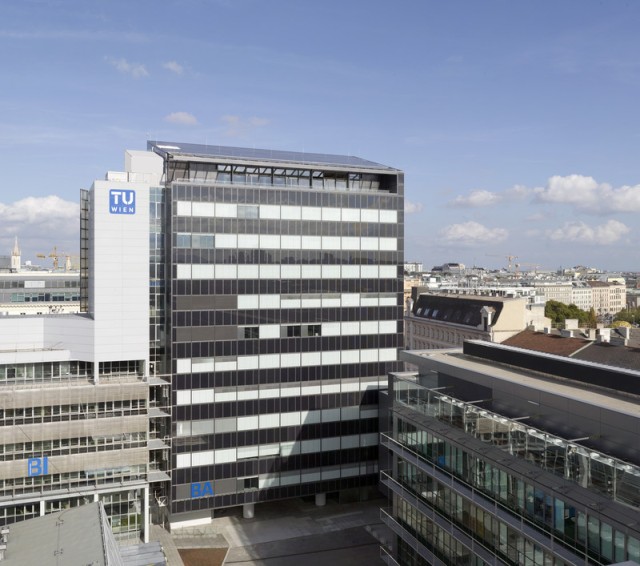Nov 20 2014
The 'Plus-Energie-Bürohochhaus' (Energy-plus office tower) is the first office tower in the world to be able to claim to feed more energy into the power grid than is required to operate AND use the building. Innovation Minister Alois Stöger opened the building on the TU's Getreidemarkt campus on 6 November 2014.
 Plus-Energie-Bürohochhaus
Plus-Energie-Bürohochhaus
The 'Plus-Energie-Bürohochhaus' is an unprecedented form of research and construction project implemented by TU Wien in cooperation with the Federal Ministry of Science, Research and Economy and BIG.
When it comes to new detached homes, the construction of energy-plus buildings is no longer the challenge it once was. TU Wien is proving that compliance with energy-plus standards is possible even for extremely complex projects: in two years, TU Wien's former Chemistry building has been completely renovated, resulting in a 'building of the future' and Austria's first 'Plus-Energie-Bürohochhaus' (energy-plus office tower).
The Austrian Ministry for Transport, Innovation and Technology (bmvit) provided 600,000 euros of funding to cover the costs of research and of the technology. "For me as the Minister for Technology, it is a particularly nice feeling when our research efforts turn out to be as impressive and tangible as this building", says Federal Minister Alois Stöger. "This building generates its energy in a highly innovative way, via the largest photovoltaic system ever integrated into any building in Austria. The technology is equally as innovative, reducing the original energy consumption by up to 93 percent. Via the 'building of the future' and 'town of the future' schemes, bmvit has been funding sustainable and energy-efficient building technologies for 15 years, which makes us one of the world's leading countries in this field." Since 1999, more than 63 million euros of funding has been provided to in excess of 450 research projects. A new call for tenders is currently ongoing for projects in the area of forward-thinking building technology, work valued at 3 million euros.
The new findings from the research project have set the standard for upcoming projects and construction activities for TU Wien and are already being applied for all TU sites e.g. through more efficient computers, shut-down of technical equipment overnight etc.
"The Plus-Energie-Bürohaus is a particularly good example of an innovative model for collaboration in the sustainable renovation of old building structures. TU Wien has been an excellent partner for us, as not only is it forward-thinking, it also seizes the initiative and takes action," says Hans-Peter Weiss, Head of BIG.
A 'plus plus' building
"It's the best building in the world," says Professor Thomas Bednar from TU Wien. He is the scientific project manager for the building project and has worked with his team to research how the concept of an energy-plus office tower could be made reality. "In tower block buildings with multiple floors, there is only a relatively small amount of roof space available for photovoltaics," explains Bednar.
The term 'energy-plus building' can itself be used in different ways, with the energy generated by photovoltaics on the building often simply being equated with the energy required for ventilation, lighting, heating and cooling. This is far from being all the energy the building requires, however. "We have factored every aspect of use into our calculations, right down to the computers and the coffee machine," says Thomas Bednar. "So maybe we should call it a 'plus plus' building instead."
Looking at yearly averages, it is possible to obtain all the energy required across the eleven floors directly from the building. This is thanks to a façade with optimised heating, sun protection and lighting technology, which has the largest photovoltaic system ever integrated into any façade in Austria.
Great success from thousands of ideas
There is no one major feature that makes the building the 'Plus-Energie-Bürohochhaus'. Instead, countless components were coordinated. "Sticking photovoltaics on a building doesn't automatically make it energy-conscious", stresses Thomas Bednar. The architects' consortium Hiesmayr - Gallister - Kratochwil was the general contractor, with scientific back-up provided by the TU Wien research team and Schöberl & Pöll GmbH, specialists in building physics, for the entirety of the planning, construction and commissioning process.
Architect Gerhard Kratochwil describes how the collaboration worked: "We have an exciting, two-year-long planning process under our belts. The teamwork carried out by 20 highly motivated science and industry experts meant that there was a constant exchange of expertise between all involved. Complex correlations were scrutinised time and time again, targets re-evaluated after being met, until theory and practice finally came together in the design."
A new kind of workplace
Around 800 employees from the Faculty of Mechanical and Industrial Engineering moved into the new offices over the summer. Teaching has also been taking place in the lecture theatres and seminar rooms since the start of the semester.
The building adjusts automatically to external conditions, but is not intended to take things out of the control of people. It remains possible to control the temperature, lighting and blinds, as well as open the windows, on an individual basis.
"We are making technology tangible for people here with this extra innovation. We are seeing for ourselves what happens if you combine basic scientific principles, application-orientated research and concrete implementation. We're then able to pass on this added value to society," says the TU's Rector Sabine Seidler to sum up.